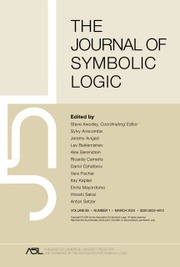Article contents
Stability theory for topological logic, with applications to topological modules1
Published online by Cambridge University Press: 12 March 2014
Extract
In this paper I show how to develop stability theory within the context of the topological logic first introduced by McKee [Mc 76], Garavaglia [G 78] and Ziegler [Z 76]. I then study some specific applications to topological modules; in particular I prove two quantifier élimination theorems, one a generalization of a result of Garavaglia.
In the first section I present a summary of basic results on topological model theory, mostly taken from the book of Flum and Ziegler [FZ 80]. This is done primarily to fix notation, but I also introduce the notion of an Lt-elementary substructure. The important point with this concept, as with many others, appears to be to allow only individuals to appear as parameters, not open sets.
In the second section I begin the study of stability theory for Lt. I first develop a translation of the topological language Lt into an ordinary first-order language L*. The first main theorem is (2.3), which shows that the translation is faithful to the model-theoretic content of Lt, and provides the necessary tools for studying Lt theories in the context of ordinary first-order logic. The translation allows me to consider individual stability theory for Lt: the stability-theoretic study of those types of Lt in which only individual variables occur freely and in which only individuals occur as parameters. I originally developed this stability theory entirely within Lt; the fact that the theorems and their proofs were virtually identical to those in ordinary first order logic suggested the reduction from Lt to L*.
Information
- Type
- Research Article
- Information
- Copyright
- Copyright © Association for Symbolic Logic 1986
Footnotes
This paper is based on Chapter IV of my doctoral dissertation [Ku 84] prepared under the direction of Dr. M. Makkai at McGill University. I would like to thank Dr. Makkai for his patient and stimulating guidance. I would also like to acknowledge the financial support received through scholarships and grants from the Natural Sciences and Engineering Research Council of Canada (NSERC) and through FCAC Québec.
References
REFERENCES
- 4
- Cited by

